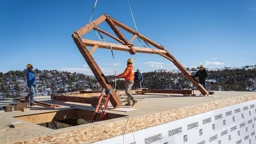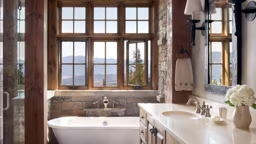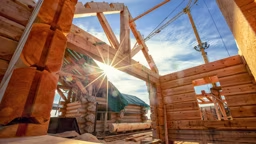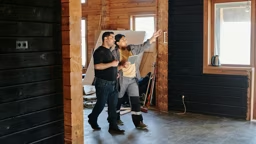
Plans and Photos: Courtesy of Riverbend Timber Framing
In Part 2 of our “Welcome Home” series, we learned what went into designing this Marysville, Ohio, family getaway. Together, with representatives from Riverbend Timber Framing, the homeowners mapped out ample space for their unique furniture pieces, as well as communal areas for entertaining. They wanted room to host large gatherings and plenty of windows to fill the space with natural light. With the design finalized, it’s time to see what goes into crafting the timber frame that will turn the family’s dreams into reality.
Like the home’s design, the timbers focus on function. “There’s a lot of traditional mortise-and-tenon joinery in this project,” says Morgan Ruhl, the shop supervisor who oversaw much of the home’s timber fabrication. “This isn’t fancy joinery; the purpose is strength. Keeping it simple gives a timeless look.”

Beginning as 8-by-12-inch beams, the interior timbers were trimmed down to 7-by-11-inches. The 18-foot exposed rafters show off the clean lines of the milled timbers, while details like curved braces and chamfered edges add character. (Contributing to the practicality desired by the homeowners, chamfers also prevent splinters and, in a worst-case scenario, are reported to catch fire and burn more slowly than squared, sharp edges.)
After the timbers were cut and sanded, they were treated with a linseed oil blend to amplify the natural grain and provide an initial layer of protection. “We’ve been using this oil for so long our supplier actually refers to it as ‘Riverbend Finish Oil,’” says Morgan with a laugh.

After the timbers were stained and allowed to air dry, they were prepped for transportation and grouped into bunks, which are different sections of the frame that will be built together during construction. This home was divided into ten bunks, each weighing around 3,000 pounds. To enclose the frame, structural insulated panels (SIPs) from Insulspan were installed to reduce heat loss and prevent air leakage. (SIPs are considered more efficient than spray foam or batt insulation and can significantly reduce energy costs over time.)
Because fabricating a home involves so many elements and small mistakes can result in big costs, the entire timber frame, from the rafters to the girts, was test-assembled before shipping, much like a dress rehearsal before the grand unveiling. In keeping with Riverbend’s “Total Home Solution” strategy, several workers who contributed to the fabrication process accompanied the timber to the job site to oversee the installation process.











